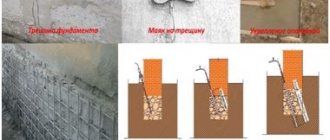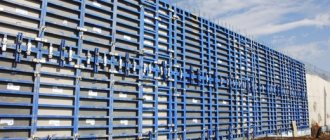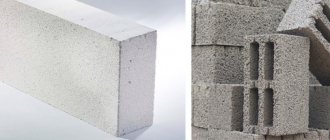Standard and design resistances of reinforcement
For the standard tensile strength of rod reinforcement ( Rsn
) the smallest controlled value of the yield strength is accepted with a security of 0.95, i.e.
(2.11)
The calculated tensile resistance of reinforcement for calculations for limit states of the first and second groups is determined by dividing the standard resistances by the corresponding reliability coefficients for the reinforcement, i.e.
(2.12)
where gs is the reliability coefficient for reinforcement, taken equal to:
for limit states of the first group:
1.1 – for fittings of classes A240, A300 and A400;
1.15 – for fittings of class A500;
1.2 – for fittings of class B500;
1.0 – for limit states of the second group, i.e.
(2.13)
Design compression resistance of rod reinforcement of classes A240, A300, A400 Rsc,
used in calculations for limit states of the first group, in the presence of adhesion to concrete, Rsc
| |, since with such reinforcement the yield strength of steel under compression is usually reached before the destruction of the compressed reinforced concrete element.
Structure of calculation formulas
In calculations for bearing capacity (based on the limit states of the first group), they proceed from stage III of the stress-strain state. In this case, the fulfillment of the condition is checked
Fult
(2.14)
where F –
the probable greatest force that can occur in an element under exceptionally critical, but still possible, circumstances;
Fult
– the probable minimum load-bearing capacity of the element, determined taking into account the reduced versus controlled strength of concrete and reinforcement.
Variability of F
and
Fult,
as a rule, is described by the law of normal distribution of random variables. Condition (2.14) can be depicted graphically (Fig. 34).
Rice. 34. Distribution curves:
a – forces from external load in the design section; b – load-bearing capacity in the same section: – average value of force from external load ( Nн
);
N –
calculated value of force; – average value of the bearing capacity of the element; F – the value of bearing capacity taking into account the reduced versus controlled strengths of concrete and reinforcement
In more detail, condition (2.14) can be written as follows:
, (2.15)
where C –
a coefficient that takes into account how accurately the selected design scheme reflects the operation of the actual structure and other factors;
S –
coefficient that takes into account the shape and dimensions of the cross-section of the element.
Taking into account that and , a Rb = , Rs = ,
inequality (2.15) can be written somewhat shorter
(2.16)
Let us estimate explicitly the real safety factor, which is obtained when calculating using this method, by equating
F=Fult
. (2.16 a)
When determining k
for a short centrally compressed concrete element, we assume that
N n = N expl.
Taking this into account, (2.16 a) can be rewritten as follows:
, (2.16 b)
where A
– cross-sectional area of the element;
= 0.9 – coefficient that is entered when calculating concrete structures.
Taking into account the fact that Npazp = ,
formula (2.16 b) can be written as follows:
where
Similarly, we can write down the conditions that must be met when calculating the limit states of the second group, i.e. when calculating deflections, crack opening widths and when calculating crack formation.
Calculation of displacements usually consists of determining the deflection of a structure due to loads, taking into account the duration of their action and comparing it with the maximum permissible deflection
f
≤
fult
, (2.17)
where fult
– maximum permissible deflection according to the standards for the structure in question.
Calculation of crack opening consists of determining the crack opening width and comparing it with the maximum permissible opening width
acrc
≤
acrc,ult
. (2.18)
Calculations of reinforced concrete elements should be made based on long-term and short-term opening of normal and inclined cracks.
The width of continuous crack opening is determined by the formula:
acrc = acrc1
,
and short crack opening – according to the formula:
acrc = acrc1 + acrc2 - acrc3
,
where acrc1
– crack opening width from prolonged action of constant and temporary long-term loads;
acrc2
– width of crack opening due to short-term action of constant and temporary (long-term and short-term) loads;
acrc3
– width of crack opening from short-term action of constant and temporary long-term loads.
It is believed that cracks do not appear if the force N
from the action of external loads does not exceed the efforts
Fcrc,ult,
i.e.
F
≤
Fcrc,ult
, (2.19)
where Fcrc,ult –
force perceived by the section at the moment preceding the formation of cracks.
The calculation method based on limit states is called semi-probabilistic. Most of the quantities included in the calculation formulas are random quantities. Standard values of loads and impacts, as well as material resistances, are justified from the standpoint of probability theory. However, the designer uses specific deterministic quantities obtained on the basis of probability theory. Thus, the theory of probability is used in the design standards of building structures in an implicit form, which served as the basis for calling the calculation method based on limit states semi-probabilistic.
The main idea of the limit state design method is to ensure that even in those rare cases when the maximum possible loads act on the structure, the strength of the concrete and reinforcement is minimal, and the operating conditions are very unfavorable, the structure does not collapse or receive unacceptable deflections or cracks
Advantages of the method:
1. By introducing into the calculations, instead of a single safety factor, a system of design coefficients that differentially take into account the influence on the load-bearing capacity of an element of load variability, strength properties of materials, operating conditions, and responsibility class, a better convergence of theoretical data with experimental data is achieved than with a single safety factor k
in previous calculation methods.
2. Each new achievement in increasing the uniformity of materials can be taken into account in the standards, which will lead to their savings.
3. Structures calculated using limit states are somewhat more economical in terms of material consumption.
Disadvantages of the method:
1. Some coefficients of the method have not received sufficient experimental justification. So, for example, the same load reliability coefficient for self-weight, used both for long-span thin-walled shell-type coverings, where the load from the mass of the covering is the main one, and for interfloor floors that operate under a significant live load, is not sufficiently justified.
2. The determination of the load-bearing capacity of elements consisting of two or more materials (for example, reinforced concrete) is currently carried out without taking into account the joint statistical spread of the strength of these materials at design resistances corresponding to the low strength of each material. The probability of finding a material with a strength below the design resistance is approximately 0.001. The probability of joint unfavorable penetration of reinforcement and concrete of minimum strength is an extremely small value (approximately 2 • 10-6), which practically cannot be encountered in operating structures. In this regard, structures designed according to the standards have additional strength reserves that are not taken into account in the calculations.
Definitions
Strength is the main quality that accurately describes its load-bearing capacity. It is determined by the compression limit - this is the highest load limit at which failure of the sample occurs. And this is the main indicator that is taken into account when using it.
Design resistance is an indicator of a material’s resistance to loading influences. It is used in design calculations, and is integrally related to standard indicators of compression resistance.
Until the 2000s, they focused only on grades of material, which were taken as a design indicator, but according to new technical documents, each grade was assigned a new criterion for the sample’s compliance with compressive loads.
It was identified in laboratory conditions, legalized by specialists and reflected in SP 52−101−2003. According to this technical document, the standard resistance of a material to axial compression is the compression class specified with 95% certainty. The condition means that it is met in 95% of tested cases, and only in 5% can it deviate from the established indicators.
But even this percentage proves that using average calculated indicators when designing is unjustifiably risky. And when choosing the smallest value, the cross-section of the structure or product will increase, which in turn will affect the overexpenditure of money and energy resources.
According to SP 52−101−2003, standard resistance values are presented in the photo below.
There is also such a definition as tensile strength. By its nature, this material can withstand tensile loads much worse. That’s why it is reinforced in reinforced concrete products, thick floor screeds, foundations, etc.
When calculating, the compression indicator is used as a priority. In principle, any product or structure experiences heavy loads precisely from compressive static or dynamic influences. But resistance to bending influences is taken into account during design. In such cases, simply use the class correspondence table.
Table 6.7 from SP 63.13330.2012 SNiP 52-01-2003, which indicates the grades of resistance to compression and tension.
View
| Concrete | Standard resistances MPa, and calculated resistances for limit states of the second group and MPa, with a material class according to compressive strength | ||||||||||||||||||||||
| B1.5 | AT 2 | B2.5 | B3.5 | AT 5 | B7.5 | AT 10 | B12.5 | B15 | IN 20 | B25 | B30 | B35 | B40 | B45 | B50 | B55 | B60 | B70 | B80 | B90 | B100 | ||
| Compression axial tension | Heavy, fine-grained and straining | — | — | — | 2,7 | 3,5 | 5,5 | 7,5 | 9,5 | 11 | 15 | 18,5 | 22 | 25,5 | 29 | 32 | 36 | 39,5 | 43 | 50 | 57 | 64 | 71 |
| Easy | — | — | 1,9 | 2,7 | 3,5 | 5,5 | 7,5 | 9,5 | 11 | 15 | 18,5 | 22 | 25,5 | 29 | — | — | — | — | — | — | — | — | |
| Cellular | 1,4 | 1,9 | 2,4 | 3,3 | 4,6 | 6,9 | 9,0 | 10,5 | 11,5 | — | — | — | — | — | — | — | — | — | — | — | — | — | |
| Axial tension | Heavy, fine-grained and straining | — | — | — | 0,39 | 0,55 | 0,70 | 0,85 | 1,00 | 1,10 | 1,35 | 1,55 | 1,75 | 1,95 | 2,10 | 2,25 | 2,45 | 2,60 | 2,75 | 3,00 | 3,30 | 3,60 | 3,80 |
| Easy | — | — | 0,29 | 0,39 | 0,55 | 0,70 | 0,85 | 1,00 | 1,10 | 1,35 | 1,55 | 1,75 | 1,95 | 2,10 | — | — | — | — | — | — | — | — | |
| Cellular | 0,22 | 0,26 | 0,31 | 0,41 | 0,55 | 0,63 | 0,89 | 1,00 | 1,05 | — | — | — | — | — | — | — | — | — | — | — | — | ||
The shear strength during chipping determines the resistance to compression and correlation indicators.
Note. Compression resistance B25 is the most commonly used indicator when designing a material.
Comparative technical characteristics of composite fiberglass reinforcement and steel reinforcement
The concept of equal-strength replacement is the replacement of reinforcement made from steel with reinforcement made from composite materials, which has the same strength and similar other physical and mechanical properties. By equal-strength diameter of fiberglass reinforcement, we mean its outer diameter at which the strength will be equal to the strength of its metal counterpart of a given diameter.
| Metal fittings class A-III (A400C) | Composite polymer fiberglass reinforcement (AKS) |
| 6 | 4 |
| 8 | 5,5 |
| 10 | 6 |
| 12 | 8 |
| 14 | 10 |
| 16 | 12 |
| 18 | 14 |
| 20 | 16 |
Tension diagram. Determination of the yield strength and tensile strength of metal reinforcement
Figure 1 shows a curve of stress versus deformation of metal reinforcement.
Figure 2 shows the approximate location of the stress-strain curves for metal and composite reinforcement (1).
σп- The highest stress up to which a material follows Hooke’s law is called the limit of proportionality. The limit of proportionality depends on the conventionally accepted degree of approximation with which the initial section of the diagram can be considered as a straight line.
The elastic properties of the material are maintained up to a stress called the elastic limit σу, i.e. this is the greatest stress up to which the material does not receive residual deformations.
σt - yield strength.
The yield strength is understood as the stress at which an increase in deformation occurs without a noticeable increase in load. In cases where there is no clearly defined yield plateau in the diagram, the yield stress is conventionally taken to be the stress value at which the residual deformation is 0.2%.
The ratio of the maximum force that a sample can withstand to its initial cross-sectional area is called tensile strength or tensile strength. Tensile strength is also a conditional value.
The unit of measurement for yield strength and tensile strength is pascal Pa. It is more convenient to measure the yield strength and tensile strength in megapascals MPa.











